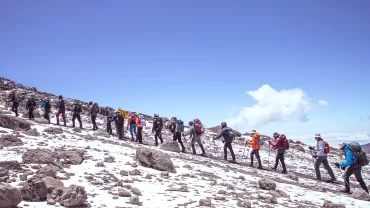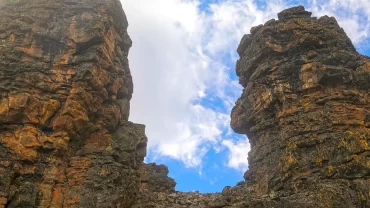The Classic Kilimanjaro Climb with Hut Accommodations
1. Introduction to the Marangu Route
The Marangu Route, often referred to as the “Coca-Cola Route,” is the only Kilimanjaro route with hut accommodations. It follows a direct, gradual ascent to the summit, making it the preferred choice for trekkers looking for a comfortable yet challenging climb.
Unlike the Machame Route, which requires camping, the Marangu Route offers dormitory-style huts at each stop. However, despite being considered an “easier” route due to its gradual incline, its relatively short duration (5-6 days) makes acclimatization more difficult, leading to a lower success rate compared to longer routes.
2. Key Facts About the Marangu Route
- Distance: ~72 km (45 miles)
- Duration: 5-6 days
- Difficulty Level: Moderate
- Scenery: Rainforest, moorland, alpine desert, glaciated summit
- Acclimatization Profile: Poor – shorter itinerary limits altitude adaptation
- Success Rate: ~50-60%
- Accommodation Type: Huts (shared dormitory-style lodging)
- Best Time to Climb: January-March & June-October
3. Route Overview & Highlights
The Marangu Route begins in the southeast at Marangu Gate, taking a direct approach to the summit. Unlike other routes, hikers ascend and descend using the same path, which can lead to more crowded trails.
Highlights of the Marangu Route:
✅ Hut accommodations – no need for camping.
✅ Most direct route to the summit – shorter distance compared to other routes.
✅ Steady incline – no major scrambling sections like the Barranco Wall on Machame.
✅ Less equipment required – due to huts, fewer logistics are needed.
4. Who Should Choose the Marangu Route?
✅ Best for:
- Trekkers who prefer hut accommodations over camping.
- Those looking for a shorter trek to Kilimanjaro’s summit.
- First-time hikers who want a less technical ascent.
❌ Avoid if:
- You want better acclimatization (longer routes like Lemosho or Northern Circuit are better).
- You prefer less crowded trails (Rongai or Northern Circuit offer more solitude).
- You want more scenic variety (this route ascends and descends the same way).
5. Pros & Cons of the Marangu Route
✅ Pros:
- Hut accommodations provide a dry and sheltered place to sleep.
- Easier logistics – no need for tents and camping equipment.
- Gradual ascent profile – no steep scrambles or technical sections.
- Shortest route – less time needed to complete the trek.
❌ Cons:
- Lower success rate (~50-60%) due to shorter acclimatization time.
- Crowded – it’s one of the most popular and busiest routes.
- Same ascent and descent path – lacks the diverse scenery of routes like Lemosho and Machame.
6. Acclimatization & Success Rate
The Marangu Route has one of the lowest success rates on Kilimanjaro, primarily because of its short duration (5-6 days), which limits proper acclimatization. Many climbers struggle with altitude sickness, forcing them to descend before reaching Uhuru Peak.
- 5-day itinerary success rate: ~50%
- 6-day itinerary success rate: ~60%
- Why? The extra acclimatization day on a 6-day trek increases chances of success by allowing more time for the body to adjust.
7. Challenges & Difficulty Level
The Marangu Route is considered moderate, but its short duration increases difficulty due to poor acclimatization.
Key Challenges:
- Altitude Sickness: Rapid ascent can make altitude adaptation harder.
- Steady but continuous ascent: No flat rest days before summit night.
- Cold Summit Night: Like all routes, temperatures near the summit can drop below -10°C (14°F).
Preparation Tip: If choosing this route, opt for the 6-day itinerary to improve acclimatization and summit success chances.
8. Best Time to Hike the Marangu Route
Like all Kilimanjaro routes, Marangu is best climbed during the dry seasons:
- January to March: Fewer crowds, cooler summit temperatures.
- June to October: Peak season with stable weather but busier trails.
Avoid: April-May & November (wet seasons, making the trail muddy and slippery).
9. Packing & Preparation Tips
Packing for the Marangu Route differs slightly from other routes due to hut accommodations:
Essential Packing Items:
- Sleeping Bag: Though huts provide mattresses, a warm sleeping bag (rated for -10°C/14°F) is necessary.
- Trekking Poles: Help with long descent after summit night.
- Headlamp & Extra Batteries: Required for midnight summit push.
- Thermal Layers: Temperatures drop significantly at higher elevations.
- Hydration System: Water bottles and/or CamelBak to stay hydrated.
For a detailed packing guide, check out The Ultimate Tanzania Adventure Packing List.
10. Comparing the Marangu Route with Other Kilimanjaro Routes
| Route | Difficulty | Duration | Success Rate | Accommodation | Crowds |
| Marangu | Moderate | 5-6 days | ~50-60% | Huts | High |
| Machame | Moderate-Challenging | 6-7 days | ~85% | Camping | High |
| Lemosho | Moderate | 7-8 days | ~90% | Camping | Medium |
| Rongai | Moderate | 6-7 days | ~80% | Camping | Low |
| Northern Circuit | Longest & Easiest | 9+ days | ~95% | Camping | Very Low |
If you want huts over tents, the Marangu Route is your best choice. However, if better acclimatization and varied scenery are priorities, Lemosho or Machame may be better alternatives.
11. Final Thoughts: Is Marangu the Right Route for You?
The Marangu Route is best suited for climbers who prefer hut accommodations and want a shorter, non-technical climb. However, its low success rate due to limited acclimatization makes longer routes more advisable for those focused on summit success.
Are you ready to experience Kilimanjaro’s classic route? Start planning your adventure today!
For more insights, check out How to Choose the Best Kilimanjaro Route.





Comment (0)